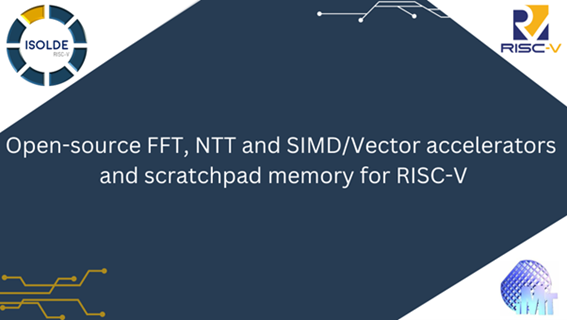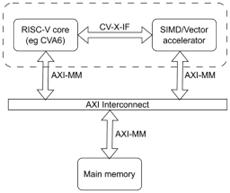
In the ISOLDE Project, IMT contributes to both algorithm development and digital designs. We are adapting split-radix algorithms for hardware acceleration of the Fast Fourier Transform (FFT) used in signal processing and high-performance computing, as well as for Number Theoretic Transforms (NTT) applied in post-quantum cryptography. Additionally, we are designing a SIMD/Vector accelerator optimized for matrix operations and a high-bandwidth, multi-port scratchpad memory.
At IMT, we utilize FFT for specially designed coded sequences in acoustic sensors, enabling longer acquisition times to achieve a better signal-to-noise ratio. A hardware-accelerated FFT will allow IMT to dynamically adapt these coded sequences to time-varying environmental conditions. Additionally, we employ FFT to solve partial differential equations on periodic cells, facilitating the estimation of macroscopic properties from 2D/3D images of microstructures. These applications span a broad range of physical phenomena, including two-phase flow prediction in porous media, the dielectric behavior of biological cells, and anisotropic crystal plasticity in metals and metallic alloys. This creates opportunities for real-time integration of micro-macro predictions into quality assessment and control systems.
Separately, we investigate algorithms for the Number Theoretic Transform (NTT), the counterpart of the FFT for integer arithmetic in finite fields, with applications in fast polynomial multiplication within finite polynomial rings. This operation is among the most computationally and energy-intensive tasks in Post-Quantum Cryptography (PQC) based on Ring/Module Learning With Errors. A challenge is that only a limited selection of finite rings supports NTT. While some PQC algorithms are specifically designed around NTT-friendly choices, others deliberately avoid them to reduce the attack surface. Our work focuses on developing universal NTT algorithms, leveraging complex transforms for generalized Mersenne primes and real transforms for powers of Fermat primes.
IMT also contributes to the development of a SIMD/Vector accelerator, a tightly coupled hardware extension for RISC-V cores. This accelerator features software-defined two-dimensional registers and enhances matrix operations, which are widely used in Artificial Intelligence (AI), particularly in Machine Learning (ML). It is integrated with the main core via the RISC-V extension interface, specifically the new CoreV-eXtension-Interface (CV-X-IF).
The proposed accelerator has two interfaces: one connecting to the main core and another to the main memory which is also used at unloading memory operations from the core. The new CV-X-IF interface for RISC-V cores enables the extension of the Instruction Set Architecture (ISA) with new opcodes and provides direct access to core registers, significantly simplifying the design of tightly coupled accelerators. Figure 1 illustrates the accelerator’s role in the system and its interactions with other components.


Figure 1. SIMD/Vector accelerator: Interfaces and internal organization
The National Institute for R&D in Microtechnologies IMT-Bucharest (Romania) is a non-budgetary public research unit. The main research fields are in closed connection to four Key Enabling Technologies: micro-nanoelectronics, photonics, nanotechnology and advanced materials.
The research centers that compose IMT are MIMOMEMS : European Research Centre of Excellence (Micro- and nano-systems for radiofrequency and photonics), CNT-IMT: Center of Nanotechnologies, CINTECH: Research Centre for integration of technologies (micro-nano-biotechnologies) and CENEASIC: Research Centers for nanotechnologies devoted to advanced carbon based integrated nanosystems and nanomaterials. The latter is also one of the fabrication facilities inside IMT, alongside MINAFAB: Center for Micro and NAnoFABrication.
The laboratories inside the institute that drive innovation across various fields include microsystems for biomedical and environmental applications, nanobiotechnology, molecular nanotechnology, micro-nano photonics, micromachined structures, microwave circuits and devices, as well as simulation, modeling, and reliability. With a team of 200 experts in electronics, computer science, physics, chemistry, and biology, IMT has participated in over 100 European projects (Horizon Europe, H2020, FP7, FP6, bilateral cooperation). As a result, it has become a recognized partner in numerous multidisciplinary consortia and networks.